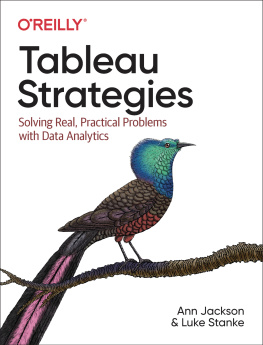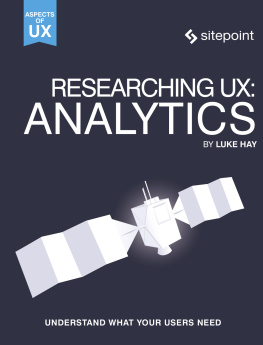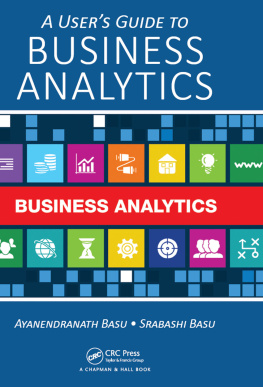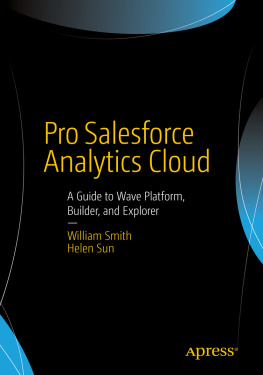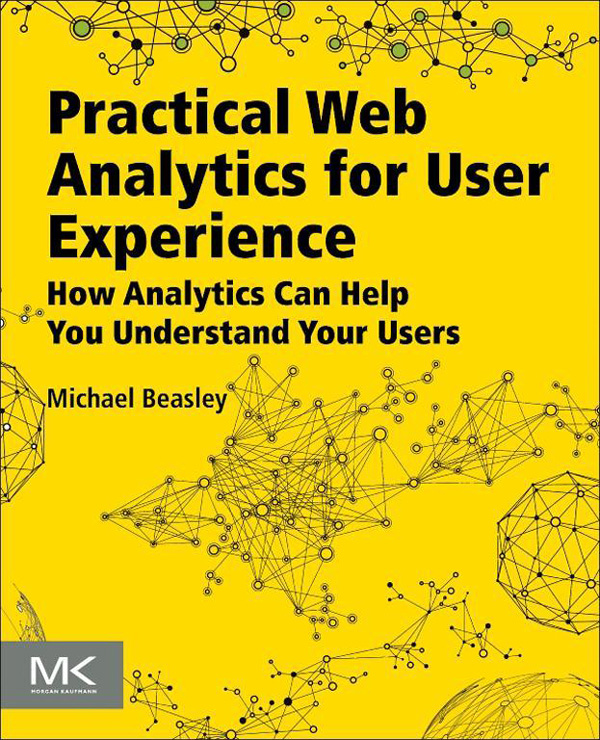Copyright
Acquiring Editor: Meg Dunkerley
Editorial Project Manager: Heather Scherer
Project Manager: Priya Kumaraguruparan
Designer: Greg Harris
Morgan Kaufmann is an imprint of Elsevier
225 Wyman Street, Waltham, MA, 02451, USA
Copyright 2013 Andrew Michael Beasley. Published by Elsevier Inc. All rights reserved
No part of this publication may be reproduced or transmitted in any form or by any means, electronic or mechanical, including photocopying, recording, or any information storage and retrieval system, without permission in writing from the publisher. Details on how to seek permission, further information about the Publishers permissions policies and our arrangements with organizations such as the Copyright Clearance Center and the Copyright Licensing Agency, can be found at our website: www.elsevier.com/permissions.
This book and the individual contributions contained in it are protected under copyright by the Publisher (other than as may be noted herein).
Notices
Knowledge and best practice in this field are constantly changing. As new research and experience broaden our understanding, changes in research methods or professional practices, may become necessary.
Practitioners and researchers must always rely on their own experience and knowledge in evaluating and using any information or methods described herein. In using such information or methods they should be mindful of their own safety and the safety of others, including parties for whom they have a professional responsibility.
To the fullest extent of the law, neither the Publisher nor the authors, contributors, or editors, assume any liability for any injury and/or damage to persons or property as a matter of products liability,negligence or otherwise, or from any use or operation of any methods, products, instructions, or ideas contained in the material herein.
Library of Congress Cataloging-in-Publication Data
Beasley, Michael, 1980
Practical web analytics for user experience: how analytics can help you understand your users / Michael Beasley.
pages cm
Includes bibliographical references and index.
1. Web usage mining. 2. Internet usersAttitudes. 3. Web sitesDevelopment. I. Title.
ZA4235.B43 2013
006.3dc23
2013010542
British Library Cataloguing-in-Publication Data
A catalogue record for this book is available from the British Library.
ISBN: 978-0-12-404619-1
Printed in the United States of America
13 14 15 16 17 10 9 8 7 6 5 4 3 2 1

For information on all Morgan Kaufmann publications visit our website at www.mkp.com
Acknowledgments
This book exists because of the help of several people. Id like to thank the people who have read this book and offered feedback along the way: Daniel ONeil, Christina York, and Mark Newman whose technical review made this book considerably better; Andrew Grohowski and Barbra Wells, who was also the person who got me thinking I could write this; the people at Pure VisibilityDunrie Greiling, Linda Girard, Jeremy Lopatin, Bill Smith, and morewho pushed me and helped me learn and gave me the space to make mistakes; awesome clients like Lisa Ocasio and Harmony Faust who asked the questions that made me dig deeper and find new ways to use data; Veronica Machak for listening to me complain and taking my first professional photo; Emily Merchant for being my writing buddy and also listening to me complain; and Melissa Bowen, who supported me and helped me clear the time I needed to work and, of course, listened to me complain. And thanks to Mom and Dad for the love and support over the years.
About the Author
Michael Beasley is a user experience (UX) designer at ITHAKA and has eight years of experience in usability testing, user interface design, and web analytics. Previously, he was the measurement team lead at Pure Visibility, where he fused web analytics with traditional UX activities to better answer clients questions about their customers. Mike earned his MSI degree in humancomputer interaction at the University of Michigan School of Information, and was active for several years on the board of the Michigan chapter of the User Experience Professionals Association. Mike has written articles for User Experience magazine and has given talks and workshops on web analytics geared toward UX professionals.
Chapter 1
Introduction
Contents
Imagine you have just wrapped up a round of usability testing on your organizations website. Half of your 10 test participants clicked on a misleading link and then immediately clicked the Back button and tried a different link. Clearly, theres a problem here, but key stakeholders are unconvinced. They tell you that your sample size is too small to produce any statistically significant findings. Luckily, you have web analytics data available to you, and you can show that this is a common path for 63% of the websites users over the last year. In addition, users spend, on average, among the lowest amount of time on that page that they accidentally go to compared to the rest of the website. Not only do you now have more evidence to show to stakeholders, you also have a better sense of the scale of the problem.
It turns out that your organizations web analytics expert had often wondered why the average time on that page was so low, yet had so many pageviews. He knew something was wrong with those two pages because of the way users moved back and forth, but it was data from the usability test that showed exactly how the labeling misled some users.
User experience (UX) professionals have a strong track record of building bridges to other fields and finding ways to utilize whatever data they can gather. Web analytics is one such valuable source of data. Web analytics experts can be a great ally, helping UX professionals understand data and find ways to measure aspects of user behavior that they need. In turn, UX professionals provide web analytics experts with a perspective on users that they cant readily access.
However, UX professionals, like yourself, who work with websites and mobile applications (apps) can get a great deal of value from learning to work directly with web analytics. Using these tools not only allows you more immediate access to data, it also allows for the kind of open exploration and deep, iterative analysis that can be challenging when you work through an intermediary. A major drawback of relying on web analytics experts is that they wont necessarily focus on the kinds of questions that are important to youthey may focus on measuring the effectiveness of online marketing efforts or simply filling requests for data. Adding web analytics tools as a regular part of your practice lets you build expertise in answering questions about users behavior and measuring the effectiveness of design changes. Web analytics can also help you communicate with stakeholders about how usability problems affect users and help you argue for important design and research activities.


